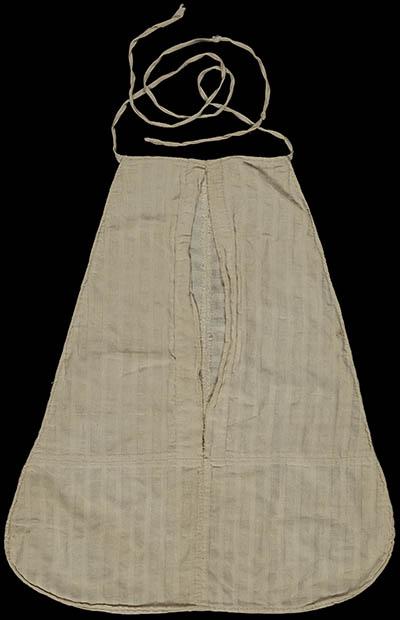Collections Online
Dimity pocket belonging to Abigail Adams
To order an image, navigate to the full
display and click "request this image"
on the blue toolbar.
-
Choose an alternate description of this item written for these projects:
- Object of the Month
- MHS 225th Anniversary
- Fashioning the New England Family
- Staff Favorites
- Main description
[ This description is from the project: Revolutionary-era Art and Artifacts ]
This dimity pocket was worn by Abigail Adams (1744-1818) in the late 18th or early 19th century. An accompanying note by Abigail's granddaughter, Elizabeth Coombs Adams, reads: "All old ladies wore these under pockets & carried their keys in them." The pocket is 14 inches long and would have been tied above her petticoat and under her skirt.
Separate pockets worn around the waist such as this one came into use in the 17th century, first as outerwear, then under ones’ garments, reaching their height of popularity in the eighteenth and early nineteenth centuries. Women’s pockets like these were employed until pockets began to be sewn into the side seams of skirts.
This pocket is composed of eight pieces of dimity sewn together with an opening halfway down the front. Two ties are attached to the top seams of the pocket to be secured around the waist. The simple and sturdy striped fabric of the pocket--the polar opposite of the sheer cotton known today as dimity--suggests that this was a utilitarian garment to be tied under an apron or worn beneath a skirt and accessed through an opening in the outer garments.
The importance of pockets in Abigail's daily life is recorded in her letters to family and friends. On 22 May 1786, she also described the safekeeping of a long anticipated letter from Charles Storer, secretary to John Adams: "I wishd to open it, but so much company present I could not, so I put in my pocket." The roomy nature of pockets made them useful for the storage and organization of a number of objects, and their functionality independent of a garment allowed for items to be carried and concealed without disrupting the line of a dress.

